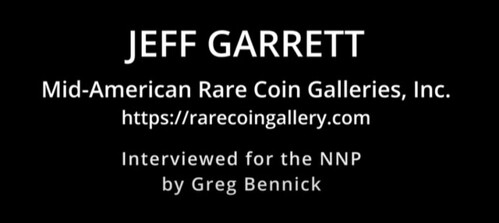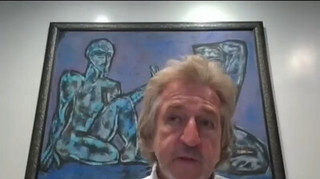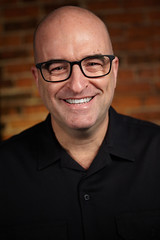
PREV ARTICLE
NEXT ARTICLE
FULL ISSUE
PREV FULL ISSUE
JEFF GARRETT INTERVIEW, PART THREEHere's the third and final part of Greg Bennick's interview with dealer and Redbook Editor Jeff Garrett, where the topic turns to great coins. -Editor Greg Bennick: Tell me this, just shifting gears just slightly because I could talk about grading all day long. I'm always in a process of learning myself. But what are some of your favorite coins that you've handled out of the millions of coins or hundreds of thousands or whatever it is that pass through your hands every year? I mean, over time, what are some of your favorite coins that you've handled throughout your career?
Greg Bennick: Are there any coins that you wish you handled? Meaning the one that got away, those sorts of things? I know that I've got a few of my own certainly, but I'm really curious to know about yours. Jeff Garrett: Yeah, you know what's funny, it's like this 1919 penny kind of brings it to mind. If I had to go back in time and tell my younger self, I would've said how many times did I own like a 1945 dime in MS-68 that I probably sold for $30? If I'd had any idea or an inkling that thirty years later people would pay insane money for relatively modern coins, like a set of Lincoln pennies or Jefferson nickels and things like that. So they might not have been the most interesting, but I wish I'd have had the foresight to understand superb gems. And there's been some people who have done that back in the day, we all thought they were almost kind of crazy. They would pay like crazy money for a coin because it was like, oh, it had unbelievable toning , they pay $300 for Morgan dollars. Like, oh, that's crazy and now those are $30-40,000. So probably going back in time, I'd let a lot of really great superb coins slip through my fingers that I sold that probably, if I had any foresight at all, I probably would've kept them.
Greg Bennick: So here's an interesting question that just came to mind. What are those coins
now? Meaning that certainly thirty years from now, people will be sitting around, maybe 50
years from now, they are going to be sitting around thinking,
Jeff Garrett: Yeah, well I had a conversation like this just recently with a friend and I told
him about…it goes back to what I told you originally about the coin business, it is about
supply and demand. So, if somebody came in and said So, I think in the long run, 40, 50 years from now, you know, an 1881-S Morgan Dollar, I don't care how good you think it is, it's still going to be a common coin because there's tens of thousands of them out there. But an 1889 CC dollar in MS-63, that's a good coin. And if the numbers of collectors grow, theoretically there's going to be more people collecting Morgan dollars and they're going to need those key dates. So, I think the supply and demand factor, if you think about it, the focus on key coins regardless of the series or regardless of the country or ancient coin, modern coin, whatever it is, I think that you have the leverage of demand that'll always be in your favor. And that's what I would think is a good idea. Greg Bennick: Speaking of, what did it feel like when you bought the 1913 Liberty nickel. I've seen the video and you were very, what's the word, understated in that moment? If it was me, I would've done a backflip off the chair and I would've been screaming and yelling. You were very understated, very calm. What did it feel like to buy the 1913 Liberty nickel?
Jeff Garrett: Well, it was more of like a shock moment because…I've written a couple
articles about it, but I didn't know I was going to buy that coin earlier in the day. I called my
good friend Larry Lee, who I knew had a couple of big clients. I said,
I did tell someone, it's interesting lately we've been talking about, it's kind of sad that because
of the pandemic, auctions now have been driven all online. And that was probably one of the
last…well there's been a few instances lately, you know, The Bass sale they did live and had
some clapping, but still not like this was. There were hundreds of people in the room.
Hundreds. And when the coin went off, it was a roar of applause. I go outside, the press was
there, I get interviewed. Now a coin sells for $8 million, and it's like, Greg Bennick: Yeah, time just flies. That's amazing. And there is something about the live auction room that just can't be replicated. I mean, there's just an energy. I remember years ago, I flew to Baltimore. I'm from Seattle, and I flew to Baltimore to bid on an error coin. It was a counterbrockage Liberty, nickel, and I had wanted this coin forever. And I flew there and my dad met me. We went to the auction. To make a long story, very short, I bid on the coin and I think my palms are sweating even now, remembering how much my palms were sweating and the energy of it and the entire experience was just transformative. So that's why I had to ask, having seen that video of you. Jeff Garrett: Yeah. And it's such a shame that it's not really how it works anymore. It's so much more transactional now than it is or is like an experience, you know, something that you would remember and have fun doing it. One of my favorite auction stories of all time was John Jay Pittman when there was an 1854 Gold dollar in proof that he knew how rare it was. He was famous for being really knowledgeable back in the sixties and it came up for auction. It's famously called the Statue of Liberty coin. And he went to the front of the room and stood there with his hand up, like the Statue of Liberty facing down on anybody who was bidding against him, and he bought the coin. And that coin was famous always for that, the Statue of Liberty coin, he wasn't going to let anybody outbid him, but that's how he did. And I had the privilege of handling that coin about 10 years ago, I sold it to, well maybe less than that, to Del Loy Hansen, the billionaire collector. So, I got to sell that coin; it was a lot of fun. Greg Bennick: That's amazing. That must have been a very intimidating moment if somebody had flown to proverbially Baltimore to bid on the coin and then Pittman standing in the front of the room like the Statue of Liberty. That's an amazing moment. Jeff Garrett: Yes facing the audience. It was pretty funny. Greg Bennick: Now last question, and you've been really generous with your time, and I don't want, as I ask this, to make it sound like you've been in the business so long that I need to ask a historical question. Don't take it that way, you're certainly not a dinosaur and I'm excited that you're here just answering all these questions with me today, it's just amazing. But when you started, there were some of the old timers…were certainly were still around. Who were the characters that you remember? I'm always fascinated by numismatic history and who were some of the old timers that you remember who maybe aren't with us anymore, who were real characters? You know, just a story that pops into your head about like the Pittman story, for example. Jeff Garrett: Well, it's funny. So I mentioned to you earlier: I grew up in Clearwater, Florida, so I had the luck. In 1974, when I was 16, the ANA convention was in Miami. And I'd never been to Miami. I hadn't really traveled much. And one of the coin dealers volunteered to take me down there and escort me down there. And I went down to the 1974 ANA and it was at the Fountainbleu. I recently stayed there with my wife. And it was kind of fun to see the old hotel, the site of the 1974 ANA and one of the vivid memories I have was…Abe Kosoff was there and that was very late. I'm not sure he lived a whole lot longer after that, but he was there and he had two showcases. He had a showcase on the right and one on the left. And in one showcase he had an ultra high relief Double Eagle, 1907 Ultra High Relief. It had recently sold for around a hundred thousand dollars, it kind of broke a new price record. And in the other case he had a mint condition Syracuse Dekadrachm, which I don't know what it was at the time. Those are both crazy coins to me at the time. But it was funny, he was dressed in a white summer suit and he was such a striking character. And I just remember seeing Abe Kosoff at his table and I was like wow, that was pretty cool to see and I still remember that. And that was my first ANA show in 1974 and luckily I've had the chance to go to every ANA convention since. I haven't missed one since 1974. So I've got a string going. I'll tell you a funny story, it's not about a character, but the 1975 ANA was in Los Angeles, which for a 17 year old kid in Florida, it could have been on Mars. It was like forever. That was a long ways away. I didn't have any money at the time and I was like gosh, I'd really like to go to that show. And I went to my local Clearwater Coin Club and there was one of the great characters at the time, was a guy named Colonel Jeffries, which people who grew up in that area probably know him. He was a really crazy character and he had an 1839 half dollar for sale and he sold it to me and it was mint condition, but he didn't realize it was a No Drapery and it was like something I'd studied. I realized it and I bought it. I think I made like $500 on it. And that gave me the money to go to the 1975 ANA in Los Angeles. So, it was really funny, my little pickoff of a variety helped me go to that next coin show. And over the years I've really been lucky, I've got to know so many of the great characters in the business. I mean, there have been so many colorful people. I remember in my area there was Robert Hendershot, he was a great character. I'm not sure if you knew him back in the day. Greg Bennick: I know the name, yeah. Jeff Garrett: Yeah, he lived to…I think he was 106 or so…kind of like Eric Newman did. And he went to the 1904 Louisiana World's Fair and he wrote a book about that later on because he was a big collector of those. And I remember buying great coins from him and some of the characters. Some of the guys that I really miss the most that became mentors was David Akers, was a really wonderful guy. He had an unbelievable memory buying coins, telling me stories from the fifties and sixties. He was always sharing with me. He was a mentor and I learned a lot from him and it really great. Even now, I consider Dave Bowers one of the great characters of all time. I consider myself lucky to call him a friend. The things he shared with me and some of the stories. But I'd have to make a list. I've really been lucky because I've done coins at the level where I got to know a lot of the great people. And it's been a lot of fun, but I'll never forget Abe Kosoff in his white suit, that's probably the most vivid one from my early years. Greg Bennick: That's fantastic. Well, I know that we've been on for near nearly an hour, so I just want to thank you for your time and those are the questions that I'd prepared. I'm sure I could come up with a hundred more, but I really appreciate you taking the time to answer them. I appreciate Newman Numismatic Portal being willing to support what's going to be a series of interviews that I'm going to do with folks. And of course, I appreciate everybody watching. This has been really fantastic. Thank you so much. Jeff Garrett: Oh, happy to do it. And I'm really happy with Newman Numismatic Portal because as we talked about it, numismatic education is the key to being a successful collector. So, people should utilize it as much as they can. Greg Bennick: Awesome. Well, thank you so much.
To watch the complete interview on NNP, see:
To read the earlier E-Sylum articles, see:
Wayne Homren, Editor The Numismatic Bibliomania Society is a non-profit organization promoting numismatic literature. See our web site at coinbooks.org. To submit items for publication in The E-Sylum, write to the Editor at this address: whomren@gmail.com To subscribe go to: https://my.binhost.com/lists/listinfo/esylum All Rights Reserved. NBS Home Page Contact the NBS webmaster 
|



